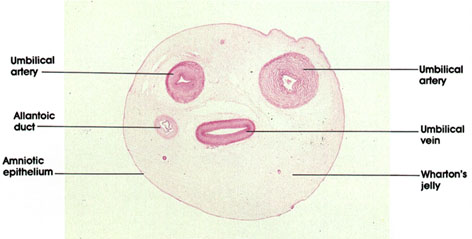

Plate 13.261 Umbilical Cord
Ronald A. Bergman, Ph.D., Adel K. Afifi, M.D., Paul M. Heidger,
Jr., Ph.D.
Peer Review Status: Externally Peer Reviewed

Human, 10% formalin, H. & E., 8.5 x.
The umbilical cord in transverse section reveals two umbilical arteries and a single umbilical vein embedded in mucous connective tissue (Wharton's* jelly). Also present is the endodermal remnant of the allantois, which extends the length of the cord in the human. The cord is covered by a simple epithelium of amniotic derivation, which becomes stratified in late gestation. The umbilical arteries are atypical of those of the remainder of the body in that they carry oxygen-poor blood, lack an internal elastic lamina, and have considerable metachromatic ground substance within their muscular tunic. They also lack an external elastic lamina, and the mucous connective tissue replaces the adventitia found in other arteries. Likewise, the umbilical vein exhibits an unusually thick muscularis, with intermingling circular, longitudinal, and obliquely disposed smooth muscle fibers. Furthermore, an internal elastic lamina is present, which serves to distinguish the vein from the accompanying arteries. Mucous connective tissue, a form of loose connective tissue, is characterized by its copious ground substance, rich in sulfated proteoglycan, which embeds a profusion of collagenous fibers. The cells of mucoid connective tissue are primitive fibroblasts, stellate in outline, which are not revealed with routine preparative techniques; their nuclei, however, are seen.
*Wharton was a seventeenth -century English anatomist.
Next Page | Previous Page | Section Top | Title Page
Please send us comments by filling out our Comment Form.
All contents copyright © 1995-2025 the Author(s) and Michael P. D'Alessandro, M.D. All rights reserved.
"Anatomy Atlases", the Anatomy Atlases logo, and "A digital library of anatomy information" are all Trademarks of Michael P. D'Alessandro, M.D.
Anatomy Atlases is funded in whole by Michael P. D'Alessandro, M.D. Advertising is not accepted.
Your personal information remains confidential and is not sold, leased, or given to any third party be they reliable or not.
The information contained in Anatomy Atlases is not a substitute for the medical care and advice of your physician. There may be variations in treatment that your physician may recommend based on individual facts and circumstances.
URL: http://www.anatomyatlases.org/